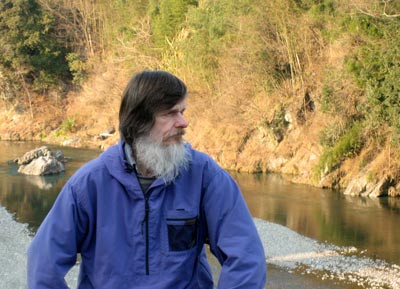Sadako's Corner
(Guest story from Sadako-san)
“Are you Mrs. Bull?”
I often help David. Since he always writes in English - essays, letters and so on - someone needs to help him translate into Japanese, and in recent years it is I who has done this for him. I also do other miscellaneous jobs when they aren’t sent to his regular part-time worker, such as mounting the prints on backboards, etc. It is so much fun to do that kind of manual job sitting side by side with him. Another important job I help him with is the annual exhibition, where I usually sit at the reception desk of the gallery and handle inquiries from the visitors. But it is there that I occasionally face a question that I can’t easily answer ... “Are you Mrs. Bull?”
How should I reply? Even though we always seem to be together, we are actually not married. We live separately, each in our own home, are quite independent from each other, and have completely separate finances. At the first few exhibitions I helped with, my reply to such questions was a mumbled ”Well ... ...”, then after a while I started saying “Something like that ...”, but sometimes when I couldn’t be bothered trying to explain, I just replied “Yes.” But these are kind of evasive answers, aren’t they? So recently, I have decided to just tell the truth, and now reply “No.” Once though, the questioner then stared at me suspiciously, her eyes clearly showing that she thought I was lying! My own eyes instantly flashed a “None of your business!” answer!
But what _is_ the appropriate word to describe our relationship? Each of us once had family around us. When we met, Dave was already divorced for some reason and I was a widow. Even during the time that we were getting closer, we each put priority on our own responsibilities as a parent. As more years went by, Dave’s daughters moved to Canada and my daughters reached an age where they are mostly independent from their mother.
We usually get along quite well, not only working together but also relaxing together: going on trips and picnics, going to the movies, out for dinner and so on. When I need assistance with something, David comes over to my house and helps with heavy garden work or similar things. If David is invited for an event or a formal dinner, then I go with him as his partner with no hesitation.
Reading this, some of you might be puzzled and ask “Then why don’t you get married?” Honestly speaking, there was a time when we thought about this, but when we gave it deeper consideration, and asked ourselves if such a move would lead our relationship in a positive direction, the answer was not so clear.
We are very different - of course from different cultural backgrounds - and often find that we have opposite views on things. Over and above this, our living styles are very different. When we list up such differences one by one, we can’t find a clear reason to start living together. Here I would like to insist that if we wanted to raise a family together the story would be very different. In that case, we would face life as a married couple with resolution, negotiating through the differences. I personally think that this is the basic reason for a couple to be married. If you expect to have a family, then you must live together, as being a parent is such an important task! But we both graduated from that stage of life some time ago, and are now ready to appreciate a more mature phase of life.
So we find no reason to put ourselves in a situation that restricts our liberty, and forces us each to cope with the (expected) conflicts that would inevitably arise. I guess David thinks the same way; it must be a precious situation for him to be able to devote himself to his printmaking work as much as he wants without being bothered by any interference.
So that’s where we are, continuing to steer our two boats towards the future. While we continue to mutually support each other, our boats may float a bit apart from time to time, but for the most part we sail along side by side. I hope that we will be able to maintain this relationship as long as we live.
“Are you Mrs. Bull?” “No, I am his partner.” Is this understandable?
 Spring has arrived again, and in what is a very unusual occurrence for me, the turn of the season is coinciding with the end/beginning of print projects!
Spring has arrived again, and in what is a very unusual occurrence for me, the turn of the season is coinciding with the end/beginning of print projects!


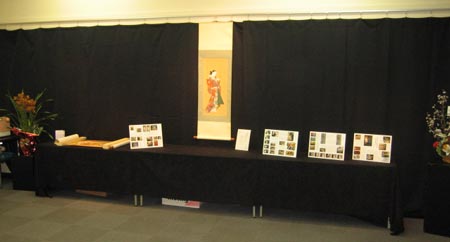
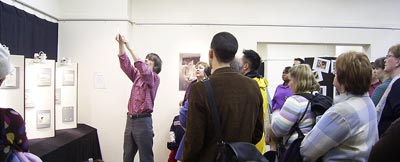
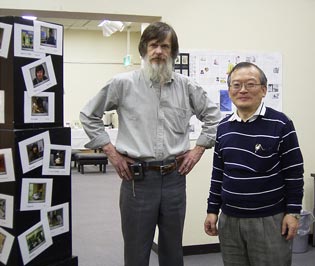 It is a matter of no small frustration for me that the Kotsu Kaikan rental timetable forces us to do all the setup on the same morning that we open the show, and as that is the most logical day for the Gallery Talk, 'Opening Sunday' is the toughest day of my entire year! But once that frantic first day is over, I can relax and spend the days chatting with friends and collectors who drop by. After weeks filled with printing work, the week-long show thus becomes a kind of 'break' for me.
It is a matter of no small frustration for me that the Kotsu Kaikan rental timetable forces us to do all the setup on the same morning that we open the show, and as that is the most logical day for the Gallery Talk, 'Opening Sunday' is the toughest day of my entire year! But once that frantic first day is over, I can relax and spend the days chatting with friends and collectors who drop by. After weeks filled with printing work, the week-long show thus becomes a kind of 'break' for me.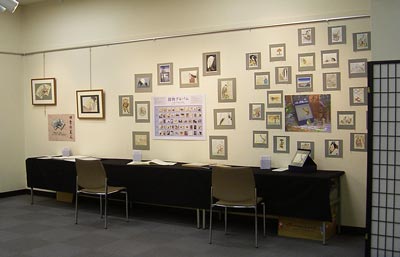

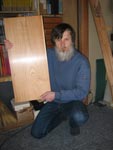 This print is very large, and woodblocks of that dimension are extremely expensive. By using a special printing table that I made, I am also able to use smaller blocks specially cut to fit the detailed areas of the design.
This print is very large, and woodblocks of that dimension are extremely expensive. By using a special printing table that I made, I am also able to use smaller blocks specially cut to fit the detailed areas of the design.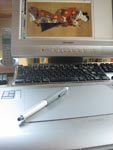 I have to make a tracing of not only all the important lines in the image, but all the patterns too. ... I prepared a full-size colour image of the original scroll, and scanned it into my Macintosh computer. ... I use a touch-sensitive tool on a 'tablet' to control the drawing. ... The tablet/stylus combination is extremely sensitive, and I can create lines that are very close to real brush strokes in appearance.
I have to make a tracing of not only all the important lines in the image, but all the patterns too. ... I prepared a full-size colour image of the original scroll, and scanned it into my Macintosh computer. ... I use a touch-sensitive tool on a 'tablet' to control the drawing. ... The tablet/stylus combination is extremely sensitive, and I can create lines that are very close to real brush strokes in appearance.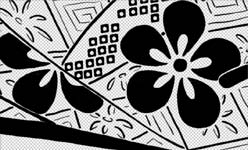 A sample of the completed 'hanshita' tracing. In order to carve a complete set of blocks for all colours in the print, I of course have to include every tiny detail of the original painting.
A sample of the completed 'hanshita' tracing. In order to carve a complete set of blocks for all colours in the print, I of course have to include every tiny detail of the original painting.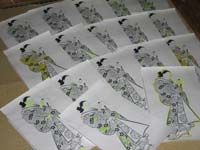 With the hanshita drawing completed, the next step was to have it duplicated, on special paper I prepared.
With the hanshita drawing completed, the next step was to have it duplicated, on special paper I prepared.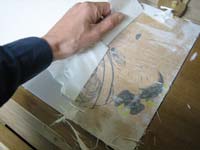 The next step was to get the colour separation sheets pasted down onto some blocks so that carving could begin. In this photo, the backing sheet is being peeled away, leaving just the thin gampi paper on the surface of the wood
The next step was to get the colour separation sheets pasted down onto some blocks so that carving could begin. In this photo, the backing sheet is being peeled away, leaving just the thin gampi paper on the surface of the wood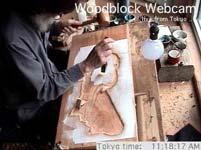 This photo is taken from the Woodblock Webcam, the video camera that looks down on my workbench, and which broadcasts live on the internet while I am working.
This photo is taken from the Woodblock Webcam, the video camera that looks down on my workbench, and which broadcasts live on the internet while I am working.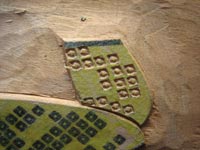 This is part of one of the pattern blocks. It's not finished at this point. All the little squares have to be cut out ... but without disturbing the tiny dots in the center of each one!
This is part of one of the pattern blocks. It's not finished at this point. All the little squares have to be cut out ... but without disturbing the tiny dots in the center of each one!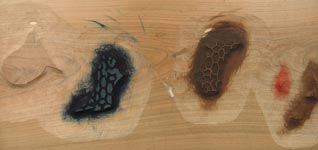 There are 13 pieces of wood used to print this design. But doesn't tell us how many printing areas we have. Because there are so many diverse colour areas in this design, it is frequently possible to combine different colours on one block.
There are 13 pieces of wood used to print this design. But doesn't tell us how many printing areas we have. Because there are so many diverse colour areas in this design, it is frequently possible to combine different colours on one block.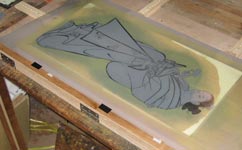 My blocks are brand-new, but I am finding that they are almost 'alive'. At every stage of the printing process, I need to constantly adjust the registration.
My blocks are brand-new, but I am finding that they are almost 'alive'. At every stage of the printing process, I need to constantly adjust the registration.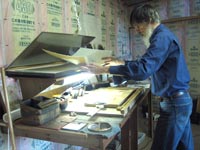 Holding it in a curved shape, I gently lift each sheet from its bed and bring it forward over the block. As you can imagine, a piece of soft and damp paper this large is very difficult to manoeuvre properly, so I keep tension across the width to keep it from flopping down too soon.
Holding it in a curved shape, I gently lift each sheet from its bed and bring it forward over the block. As you can imagine, a piece of soft and damp paper this large is very difficult to manoeuvre properly, so I keep tension across the width to keep it from flopping down too soon.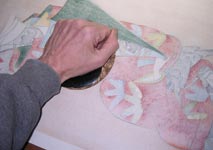 All my experience to date has been with relatively small prints, and scaling up to something of this size has brought with it so many new challenges that the work has proceeded very slowly indeed.
All my experience to date has been with relatively small prints, and scaling up to something of this size has brought with it so many new challenges that the work has proceeded very slowly indeed.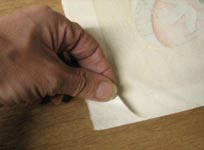 After printing is finished I have to bring the print down to the proper thickness to allow mounting as a scroll. If it were too thick, it would become creased and spoiled when rolled up.
After printing is finished I have to bring the print down to the proper thickness to allow mounting as a scroll. If it were too thick, it would become creased and spoiled when rolled up. 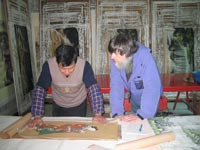 Most scroll mounting workshops these days use a modernized process involving glue and a large press, but I wanted the job to be done using traditional methods - with paste and air drying. This photo shows Mr. Wang Jianfang of Suzhou, China, studying one of the prints during our discussion. We were pleased with the samples of his work that we saw, so decided to ask him to do our job.
Most scroll mounting workshops these days use a modernized process involving glue and a large press, but I wanted the job to be done using traditional methods - with paste and air drying. This photo shows Mr. Wang Jianfang of Suzhou, China, studying one of the prints during our discussion. We were pleased with the samples of his work that we saw, so decided to ask him to do our job. Thanks to the wonderful cooperation of collector Mr. Yoko Tauchi - who is a professional calligrapher - all the collectors will receive paulownia boxes with her beautiful calligraphy on top.
Thanks to the wonderful cooperation of collector Mr. Yoko Tauchi - who is a professional calligrapher - all the collectors will receive paulownia boxes with her beautiful calligraphy on top. So here we are at the end of this long and intensive project. It has indeed been a most educational and interesting year of work. I am now a much more experienced printer than I was a year ago!
So here we are at the end of this long and intensive project. It has indeed been a most educational and interesting year of work. I am now a much more experienced printer than I was a year ago!
